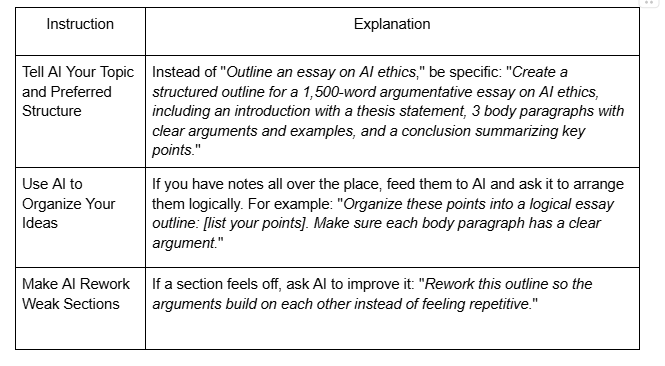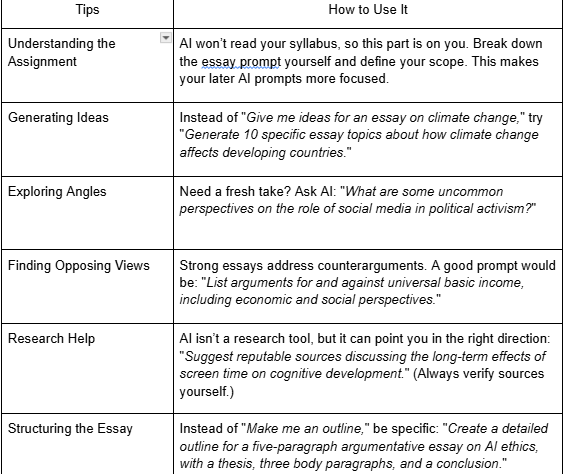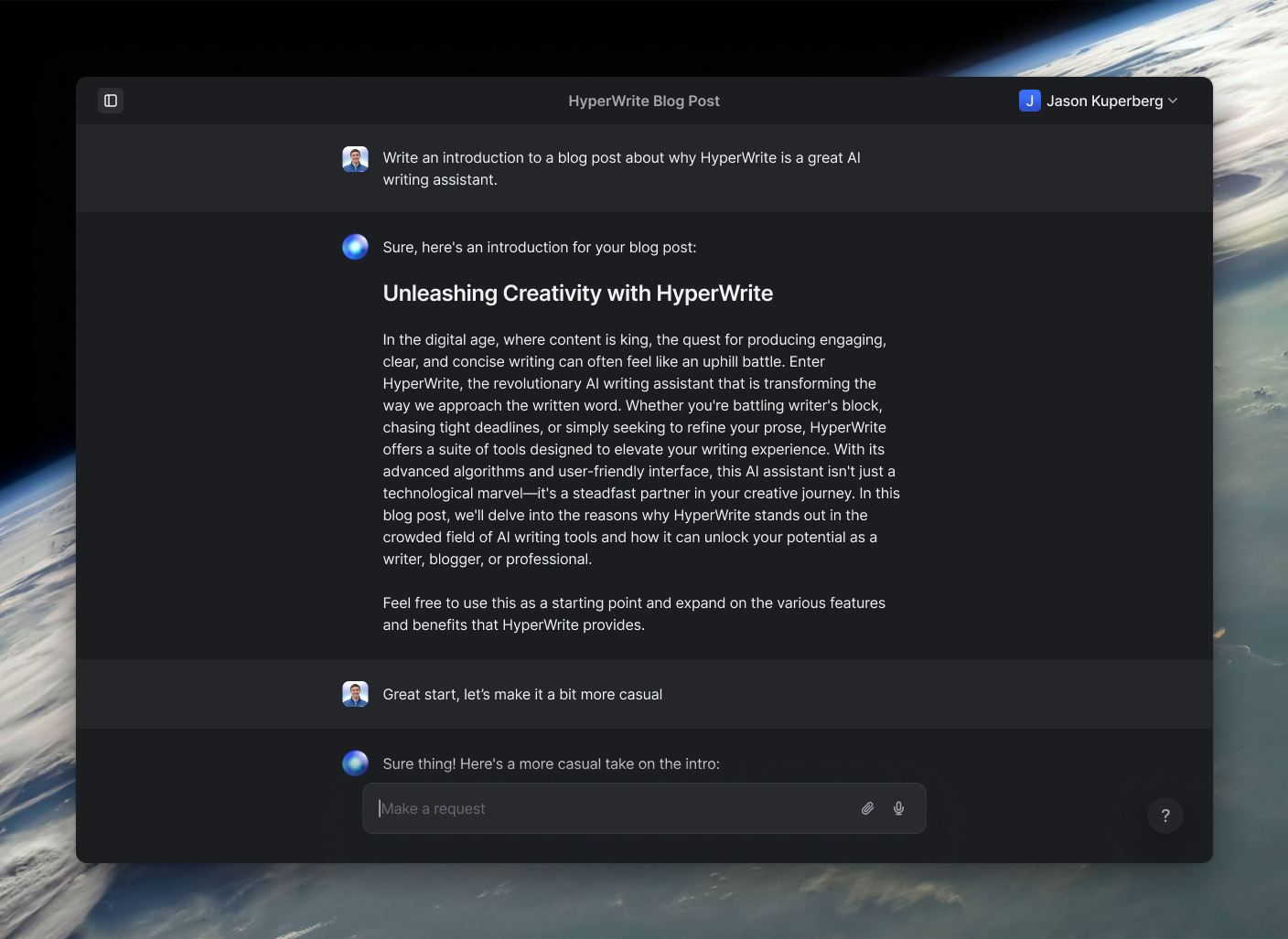
There are few things as daunting as facing a blank page. And when you're under pressure to perform, that blank page can feel like a world of endless possibilities that quickly turns into a prison of paralyzing writing prompts and formatting requirements. Whether you're preparing for an upcoming essay or research paper, the process of writing can be overwhelming. Fortunately, students today have access to smart, reliable tools that can ease the strain of writing. Using AI to write essays can help students write better, faster, and more original content, all while reducing stress. This article will cover how AI essay writers work, the benefits of using an AI writing assistant, and practical tips for getting started.
Are There Benefits of Using AI To Write Essays?

The writing process isn’t going anywhere. You know it. The blinking cursor knows it. The deadline, closing in faster than you’d like, definitely knows it. AI seems like the perfect solution: just type a prompt, let it do the heavy lifting, and boom, problem solved, except not really.
Why AI Is a Tool, Not a Shortcut, for Writing Better Essays
A recent study found that 90% of college students have used AI for academic work. Many struggle to use it correctly. Some copy-paste whatever AI generates, only to get flagged for plagiarism. Others end up with essays full of made-up sources.
And then there’s the problem of AI-written text sounding off, like a Wikipedia entry, but with fewer soul and more unnecessary details. AI can absolutely help you write better essays, but only if you know how to use it properly. It’s great for brainstorming, structuring, and editing, but it’s not a replacement for original thinking.
How AI Fits into Essay Writing
AI is here to assist. From brainstorming to structuring your work, AI can make essay writing smoother and more efficient. HyperWrite offers AI-powered tools that help students generate ideas and polish their essays without sacrificing originality.
AI as a Creative Writing Assistant
Leveraging AI tools can make the writing process easier. Used wisely, it can help you discover fresh angles and overcome creative roadblocks. You just need to see AI as a collaborator.
Here’s knowing how to write a paper with AI can help, instead of hurting your work:
Idea Expansion
You have a topic, but it feels too broad or too vague. AI can suggest specific subtopics or counterarguments that add depth to your essay.
Creative Sparks
Struggling to find an interesting way to frame your argument? AI can provide unique perspectives or phrase ideas in a way that makes them more compelling.
Structural Guidance
Instead of staring at a messy set of notes, AI can help you organize your thoughts into a clear outline, making sure each argument flows logically. Avoiding
Repetitive Writing
AI can help rephrase sentences, so your essay doesn’t sound dry or repetitive.
Finding Connections
If you’re stuck trying to link two ideas, AI can suggest transitional phrases or related concepts that improve flow and coherence.
Benefits of Using AI in Essay Writing
Using AI to write essays is about making the process faster and less frustrating. When used correctly, AI tools help with clarity, structure, research, and editing, saving you precious time.
Here’s how AI can help you write better essays:
Faster Topic Research
Finding reliable sources can be time-consuming. AI can scan articles and highlight useful studies in seconds. Instead of opening 20 tabs, you get straight to the information that matters. Some tools even suggest reliable sources to back up your claims.
Find the Right Words
AI tools rephrase confusing sentences and improve readability, all while keeping your writing style intact.
Avoid Plagiarism
Even if you’re not copying, AI can flag sentences that are too close to existing content and help rewrite them more originally.
Cut Down on Wordiness
Long sentences don’t make an essay better. AI trims unnecessary words while keeping the meaning intact, so you’re not just filling space.
Cite Sources Without Stressing Over Formatting:
Messing up a citation is easy; fixing it is annoying. AI automatically formats citations in MLA, APA, or Chicago style, so you don’t have to second-guess it.
Keep Track of Sources Without Losing Them
Found a great article but forgot to save it? AI organizes sources and notes so you always know where your information came from.
Related Reading
- Best AI Tools For Students
- Should Students Use AI
- Can You Use AI For College Essays
- Why Is AI Good For Students
- Essay Writing Tips For Students
- Can You Use ChatGPT For College Essays
- How Can AI Help Students
- College Essay Writing Tips
- How To Write The Best College Essay
- Essay Writing Prompts
- Benefits Of Using AI Writing Tools
- Types Of Essay Writing
13 Expert Tips for Using AI To Write Essays Effectively

1. Know Exactly What You’re Supposed to Write
Before using AI to write papers, you need to understand what your essay is asking for. No tool can fix a paper that completely misses the point. Professors don’t just assign essays to make your life harder. They want to see if you grasp key concepts. If you skim the prompt and start writing without a plan, you’ll end up with an essay that sounds decent but doesn’t fully answer the question. That’s an easy way to lose points.
Read the Prompt First: Why Understanding the Assignment Still Matters in the Age of AI
Some prompts require analysis, while others call for argumentation. If it says "compare and contrast," but you only describe one thing, that’s an automatic red flag. If it asks for "critical evaluation," a summary won’t cut it. Pay attention to length, formatting, and source requirements.
A five-page research paper with three academic sources isn’t the same as a short reflective essay. AI can organize ideas, but only you can ensure that you're following the instructions. Read the prompt twice. Then once more, just to be safe.
2. Get AI to Do the Hard Work (Without Making It Obvious)
AI can assist with your ideas and research, but only if you ask the right questions. A vague prompt like "Help me write an essay on climate change" will get you a generic, surface-level response. That’s useless. A good prompt is specific and focused, guiding AI toward something helpful.
Here’s how to make AI work for you:
Explore Different Angles
Instead of "Write about social media," try "How has social media shaped political activism in the last decade?" AI will generate ideas you might not have considered.
Challenge Your Perspective
If you're writing an argumentative essay, ask AI to give counterarguments. This makes your paper stronger because you’ll know how to address the other side.
Refine Your Thesis
If your topic is too broad, ask AI to suggest narrower, more specific versions. Instead of "Effects of AI in education," try "How AI is changing the way students research and write essays."
3. Create a Stronger Thesis Statement Using AI
A thesis statement helps you stay on track with your essay’s overall aim. It’s a concise statement that summarizes the main points of your essay and what readers can expect. For example, are you exploring different ideas, making an argument, or explaining something in detail?
Follow these steps to write a strong thesis statement:
- Identify and research your essay topic: Find a particular angle that interests you. Ask a research question that encourages you to explore your topic in more detail.
- Use your initial thoughts or theories to answer your question: This will be your working thesis.
- Research your question and working thesis: Review trustworthy sources to assess the strengths and weaknesses of your thesis.
- Refine your thesis: Your research may have altered your opinion or created a new angle.
4. Apply “Smart Hacks” to Boost Your Word Count
In addition to being too long, essays can also be too short. I know how frustrating it is when you have explained everything you wanted to, but are still 200 words under the word count.
Before you add filler words or rewrite the duplicate content in different sections of your essay, apply these clever hacks to your copy:
Add Examples
Examples can illustrate a point and make it easier to understand. They’re handy for explaining complex academic and technical information.
Use Quotes And References
Find valuable quotes and references that can support your essay’s argument.
Extend Your Introduction And Conclusion
This is where you can add free-flowing paragraphs without needing to validate sentences with references, sources, and quotes. Consider adding detail on what inspired you to explore your topic, or reiterate the key takeaway from your essay.
You can also share personal experiences and research findings to introduce or close your topic where appropriate.
Utilize an AI Writing Tool
AI tools like Hyperwrite can generate text. While reading through your essay, some paragraphs or points could be expanded. Paste your words into the Editor, and click “Continue Writing” for ideas on additional text you can include.
5. Hook Your Readers in Your Opening Sentence
The pressure to deliver a unique and attention-grabbing hook can make your opening sentence the hardest to craft. Before brainstorming, ensure that you have conducted in-depth research and understand your essay’s tone and audience.
Your research may uncover facts and arguments that can guide your hook, such as a shocking statistic or discovery. In addition, your intended audience will impact the tone you should use and how you should introduce readers to your essay. Sharing a joke or a light-hearted anecdote will likely be too casual for a serious argumentative essay.
Mastering the Hook: 5 Attention-Grabbing Ways to Start Your Essay
Some of the most effective ways to create an enticing hook include:
Shocking Statistics
These are facts that will surprise your readers.
Bold Claim
This is a claim that your readers don’t necessarily already accept as fact, or that they may not even have heard of.
Storytelling/Anecdote
Stories can help your readers connect with your topic and you as the author.
Questions
Asking a question can spark curiosity. An interesting question can encourage people to read your essay to find out the answer.
Description
This is a unique and specific description of something (a person, event, time period, etc.) that relates to the argument you’re making in your essay.
6. Look at Examples of Explanatory Essays
When in doubt, examples can be your best friend. Especially if you are writing an explanatory essay, as there are many different subtypes, explanatory essays examine a topic or situation in detail.
You, as the author, provide evidence and facts to explain why something happened, why something works, or what something is. The essay must have an objective perspective, and the facts must speak for themselves.
Choosing the Right Type of Explanatory Essay for Your Topic
The different types of explanatory essays include:
- How-tos: Step-by-step instructions on how to do something.
- Problem and solution: Explaining a problem and providing a solution.
- Chronology: Detailing something’s history or backstory in chronological order.
- Cause-and-effect analysis: Examining a phenomenon to explain what caused it and what influenced it.
Because of the various explanatory sub-types, it helps to look at different examples to decide which style works best for your subject. Looking at examples also gives you an idea of how to structure your essay and present your arguments effectively.
7. Use AI to Avoid Plagiarism
While there are several ways to avoid plagiarism, including expressing your research and findings in your own words and citing your sources, Wordtune can also help you. The AI technology produces text that has not been written anywhere else on the internet. See for yourself by copying Wordtune’s generated text into search engines such as Google.
Accidental plagiarism can make your work look less credible and unprofessional. In addition to making my research appear underdeveloped, not referencing sources correctly can suggest that I’m trying to pass off other people’s ideas as my own. With the right tools, you can avoid this critical essay mistake.
8. Break Persuasive Essays into Manageable Chunks
Persuasive essays use research and logic to persuade the reader of your opinion on a particular subject. In some ways, this article is persuasive because I use research and examples to persuade (or at least encourage) you to practice these essay writing methods.
If writing an argument intimidates you, this five-step list will break your essay into manageable chunks, making it easier to write.
- Identify a topic or issue that is arguable from more than one position. You must form an opinion and not argue a simple fact. Find a topic that has multiple theories and no conclusive evidence, such as “Is animal testing ethical?” or “Should students still study Shakespeare?”
- Use research to create your thesis (follow the steps mentioned earlier). Find evidence to back up your thesis.
- Double-check sources for credibility and try to spot missing information that could impact your argument. Address opposing ideas others may hold.
- Use search engines like Google to research opposing viewpoints. For instance, if I believe animal testing is not ethical, I can research “Why animal testing is ethical” to find other theories. To respectfully show different opinions, first acknowledge the opposing view and evidence. Then, share my argument and provide logical evidence as to why my argument is the correct one.
- Create a convincing conclusion. Rather than repeating what I’ve already said, draw from the arguments I’ve made and point out how they logically prove my thesis.
9. Find Information Fast, But Don’t Trust Everything
AI makes research easier, but it’s not a magic truth machine. It can summarize topics and highlight key points in seconds, until it confidently spits out a fake statistic or cites a nonexistent source.
Here’s how to use AI to write an essay without falling for bad info:
Use AI to Speed Up the Search, Not to Replace It
Instead of scrolling through endless articles, ask AI for a summary of key debates or historical events related to my topic. Then, check those sources myself.
Always Verify Sources
If an AI source provides a book or study, verify it. If I can’t find it, it’s probably made up. Even if it’s real, skim it to make sure AI didn’t twist the meaning.
Stick to Credible Sources
AI can’t tell the difference between a peer-reviewed study and someone’s opinion blog. Use academic databases or official publications to fact-check. AI helps find information faster, but accuracy is on me. Professors can spot bad sources a mile away, and nothing tanks a grade faster than citing fake research.
10. Let AI Help You Organize Your Essay
A messy essay is a forgettable essay. Using AI to write essays is about structuring your thoughts in a way that ensures everything flows smoothly.
A solid outline saves you from writing random paragraphs that don’t connect and scrambling to fix them later:

If a section feels off, ask AI to improve it: "Rework this outline so the arguments build on each other instead of feeling repetitive."
11. Let AI Help, But Don’t Let It Write for You
If I copy-paste everything it spits out, my essay will sound robotic, and my professor will notice.
The main AI writing guide trick is knowing what to use AI for and what to write myself.
- Generating Topic Sentences: If my paragraph feels awkward to start, AI can suggest a clean, direct opening. For example: "One major effect of social media on mental health is increased anxiety due to constant comparison."
- Smoothing Transitions: No more choppy paragraphs. AI can suggest transition phrases, such as "Building on this idea..." or "On the other hand, critics argue that...", to enhance the flow.
- Rewording Unclear Sentences: AI can suggest a clearer way to express it while maintaining my intended meaning. What AI shouldn’t do? Write my arguments for me. A good essay needs my reasoning, my analysis, and my voice. AI can polish my writing, but it can’t replace my ideas.
12. Clean It Up Without Losing Your Voice
Even the best essays need editing. AI can catch grammar mistakes and suggest better word choices, but it’s not perfect. AI for essay writing is a great tool for polishing your work, but it won’t think like a human, so I still need to do the final review myself. Run my essay through an AI grammar checker to catch typos. Tools like Grammarly or ProWritingAid can flag passive voice, wordiness, or unclear phrasing.
Don’t accept every suggestion blindly. AI doesn’t always understand tone or context, and sometimes its fixes make things worse. Once AI has done its part, I’ll read my essay out loud. I’ll hear awkward sentences I wouldn’t notice otherwise. I’ll check if my points connect and if the argument flows naturally. And remember, my final edit is what makes it sound like me!
13. Get AI to Give You Better Answers with Prompt Engineering Tips
AI is only as good as the prompts I give it. A lazy prompt like "Help me with my essay" won’t get me anything useful. A detailed, specific prompt? That’s when AI starts working for me. If I'm using AI to write an essay, I need different prompts for different stages of the writing process.
Here’s how to get AI to do what you need:

The better my prompt, the better AI’s response!
Related Reading
- Benefits Of AI For Students
- Steps To Writing An Essay
- Writing Prompts For Students
- Why Is My Essay Detected As AI
- Best Ways To Start An Essay
- Best AI For Medical Students
- Best AI For College Students
- Best AI Essay Writer For Students
- Free AI For Research Paper Writing
- Best AI For Essay Writing
- AI For Assignment
Try our AI Writing Assistant to Write Natural-sounding Content

HyperWrite is an AI writing tool that enhances productivity and creativity. It utilizes artificial intelligence to assist students in generating ideas and content for their writing assignments. With HyperWrite, you can create accurate and unique essays faster, and the content reads like a human wrote it.
HyperWrite is especially helpful for students who struggle with writing or have mental blocks that make it challenging to start assignments. The AI writing assistant helps you overcome these hurdles, enabling you to produce high-quality work.
Related Reading
- Best AI Apps For Students
- Best AI For School Work
- Best AI For Homework
- Free Grammarly Alternatives
- QuillBot Alternative
- Otter.AI Alternatives
- Jasper AI Vs ChatGPT
- ChatGPT Vs Grammarly
- SlidesGo Alternative

Powerful writing in seconds
Improve your existing writing or create high-quality content in seconds. From catchy headlines to persuasive emails, our tools are tailored to your unique needs.

